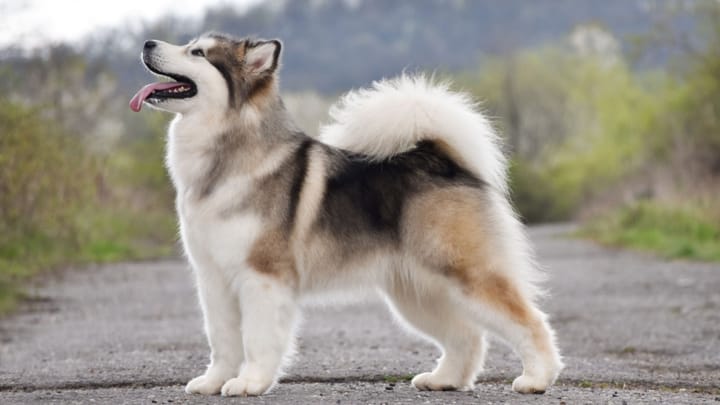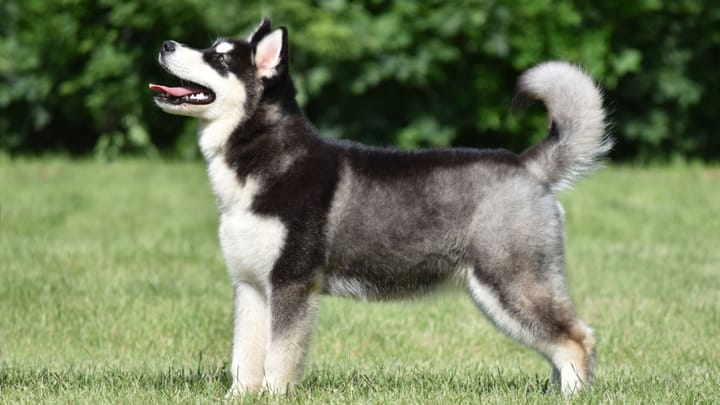Alaskan Malamute
Other names : Mal, Mally


The Alaskan Malamute was conceived for the hauling of heavy sleds, but the latter have since become an obsolete tool in the modern world: contemporary sled dog competitions are above all else a test of speed, which is better suited to more agile and flexible dogs (such as the Malamute’s nordic cousin, the Siberian Husky). Overtime, the Alaskan Malamute has therefore simply become a companion and show dog. Certain individuals- but by no means all of them- have a good watchdog capacity, but an authentic Malamute should never be vicious. The Malamute is extremely gentle and affectionate towards his family.
|
Life expectancy |
The Alaskan Malamute has a life expectancy of between 12 and 14 years |
|
Temperament |
|
|
Size |
Large
|
|
Adult size |
Female
Between 23 and 25 in
Male
Between 23 and 25 in
|
|
Adult weight |
Female
Between 75 and 84 lb
Male
Between 75 and 84 lb
|
|
Coat colour
All colours ranging from grey to black are admissible, but always with some white patching on the paws, legs, and lower body. The head can be of a variety of masks, and they should always be symmetrical. |
Blue Black |
|
Type of coat
The coat is medium-long. The coat is thick and coarse, with an abundant undercoat. |
Long |
|
Eye colour
The eyes are brown, and should be as dark as possible. Blue eyes are considered a defect. |
Brown
|
|
Purchase price |
The Alaskan Malamute costs between £550 and £690 |
During the gold rush, these dogs were in extremely high demand, as the hopeful prospectors used them to transport enormous quantities of food and supplies over the mountain tops.
The Alaskan Malamutes have been used during the Second World War, to sniff out mines, carry firearms and serve as search and rescue dogs.
With regards to the Alaskan Giant Malamute, it was considered a separate breed in its own right and not a ‘kind of malamute’. He is, however, considered to be an outsized dog in Europe and is therefore rarely seen there. He is more often taken into account and bred in Canada and the United States.
More details about the Alaskan Malamute
Alaskan Malamute: Origins and history
Originally from the Alaskan High North, he was bred by the Mahlemut people, where he gets his name from. The Mahlemut used to hunt for caribous- animals that have become extinct shortly prior to the gold rush, leaving the people without resources. The first Americans who arrived in the High North only found a few specimens of this breed. Luckily, they brought them back to the United States and further developed the breed as we know it today. The FCI officially recognised the breed in 1963.
Physical characteristics of the Alaskan Malamute
The Alaskan Malamute is a classical nordic dog, with pronounced characteristics typical of Spitz dogs. He has a strong and compact frame, yet not overly stocky; straight and powerful limbs; a brush-like tail, carried over the back like a "waving plume", but never actually touching the back. The head is adorned by upright ears, quite far apart and directed towards the front. The muzzle is elongated but not pointy. The almond-shaped eyes have a typical nordic expression and are obliquely set. Even if he resembles the Husky in many aspects, the Malamute is mightier, more big-boned, and stubborn. The Siberian Husky is faster and more slender, while the Malamute is more enduring and can haul heavier freight for longer.
Do note that there also exists the Alaskan Giant Malamute, that can weigh up to 187 pounds for males, and 154 pounds for females. The latter is the result of a cross between the Pyrenean Mountain Dog, the Newfoundland, and the Saint Bernard. This particular variety is sooner considered to be a large companion dog rather than a sled dog, since the crossing has distanced it from the ‘nordic’ aspect of the authentic Malamute.
FCI classification of the Alaskan Malamute
-
Group 5 - Spitz and primitive types
-
Section 1 : Nordic Sledge Dogs
Alaskan Malamute: Characteristics
Alaskan Malamute: Behaviour
Training a Alaskan Malamute
On account of his independent character and his nordic roots, this dog can tend to be difficult to train if the training process does not start as soon as he integrates the home.
Brutality should not be applied in any shape or form, at risk of forever compromising the master-dog relationship. A certain dose of rigor is necessary however, in order to consolidate mutual respect.
These dogs are, generally speaking, not the top of their class in terms of obedience, it would therefore be futile to try and turn them into circus monkeys. The basics of discipline (hailing, walking on a leash, holding position) will be enough to forge a functional life with this dog.
The intelligence and joviality of this dog make training sessions pleasant, though they must be held regularly, and carried out in a coherent, fair, and positive manner.
Alaskan Malamute: Lifestyle
Breed compatibility Alaskan Malamute
Alaskan Malamute: Purchase price
The price of an Alaskan Malamute varies depending on its origins, age, and gender. You have to count an average of £685 for dogs registered at the Kennel Club.
With regards to the monthly budget required to meet the needs of a dog this size, you have to estimate an average of £55 per month.
Alaskan Malamute: Shedding
Heavy !
Since this dog has a very abundant coat, he does experience significant hair loss during moulting seasons. Daily brushes must therefore be carried out to eliminate as much residual dead hairs as possible.
Alaskan Malamute: Grooming
Naturally clean, this primitive dog does not require bathing. On the flipside, however, he does require many brushes (two a week, on average) in order to preserve the aesthetic and protective properties of his beautiful, impressive coat.
Alaskan Malamute: Health
Life expectancy is estimated at 13 years.
The Alaskan Malamute is a primitive, extremely robust dog.
Even if he sheds a big part of his heavy undercoat in the summer, the Alaskan Malamute does not tolerate heat well. You must therefore always make sure that he has fresh water at his disposal, and a cool spot in the shade to retreat to.
His thick undercoat and topcoat allow him to live in the most challenging of weather conditions without a problem.
Very active and athletic, there is no reason for this primitive dog to gain weight if he is well nourished and gets the appropriate amount of exercise.
- Hip dysplasia
- Lipoma (benign tumor of the fatty tissues)
- Achondroplasia (dwarfism, malformation of the long bones)
- Alopecia X (skin condition)
- Polyneuropathy (neurological condition)







